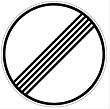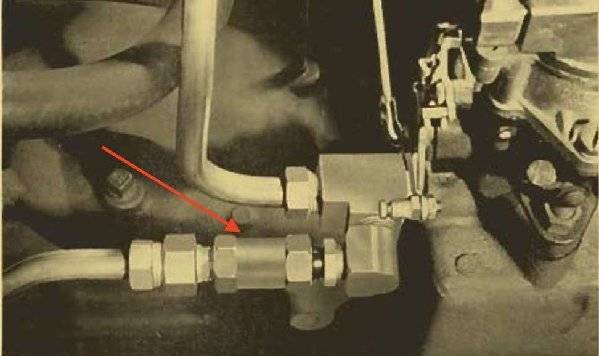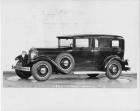|
Re: How to add a PCV Valve to a 1949 Packard
|
||||
|---|---|---|---|---|
|
Home away from home
|
Cords 810/812 used a tube to the air cleaner to vent their crankcases. I recall seeing something similar on post war 1940s civilian Jeeps.
(o{}o)
Posted on: 2015/11/15 12:24
|
|||
|
We move toward
And make happen What occupies our mind... (W. Scherer) |
||||
|
||||
|
Re: How to add a PCV Valve to a 1949 Packard
|
||||
|---|---|---|---|---|
|
Forum Ambassador
|
I had a 64 Chevy El Camino that had that arrangement of PCV thru the air filter. Another person mentioned the possibility of a large oil soaked spot or a shorter life on the air filter and that is no exaggeration. That Chevy had so much blowby one side of the filter was black in no time.
Posted on: 2015/11/15 12:46
|
|||
|
Howard
|
||||
|
||||
|
Re: How to add a PCV Valve to a 1949 Packard
|
||||
|---|---|---|---|---|
|
Just can't stay away
|
I had similar issues with fumes from the road draft tube permeating the cabin at startup, when stuck in traffic, etc.
My solution was to extend the tube to the rear of the car, ending just past the differential. I had my mechanic modify the road draft tube by creating an angled flange and welding it onto the tube's bottom end. He then fitted flexible aluminum conduit onto the flange and ran the conduit through the Packard's frame back to the rear axle. The conduit is secured in place with cable ties and there's a heatproof gasket where the conduit is hose-clamped to the flange. I realize this is not an elegant solution. However, it resulted in noticeable fume reduction inside the car without affecting engine performance in any way.
Posted on: 2015/11/18 13:38
|
|||
|
||||
|
Re: How to add a PCV Valve to a 1949 Packard
|
||||
|---|---|---|---|---|
|
Home away from home

|
This looks cool!
An adjustable PCV that you can match to your engine. http://mewagner.com/ It is a good chunk of change, but is something I would consider trying out one day....when I'm done with everything else. 
Posted on: 2017/9/14 9:58
|
|||
|
1953 Clipper Delux Club Sedan, 1953 Caribbean, 1969 912, 1990 Miata
|
||||
|
||||
|
Re: How to add a PCV Valve to a 1949 Packard
|
||||
|---|---|---|---|---|
|
Home away from home
|
One advantage to the oily film under the car is it helps keep the floor pan from rusting out.....
 John
Posted on: 2017/9/14 11:13
|
|||
|
||||
|
Re: How to add a PCV Valve to a 1949 Packard
|
||||
|---|---|---|---|---|
|
Home away from home

|
Beginning around 1966, California smog law (apparently this has been forgotten today) required a specially vented oil filler cap (and/or other similar things) which then had a flexible rubber line that ran to the engine's air cleaner. My 1959 Continentals were thusly modified.
On cars with an air pump (factory for some California cars as of 1966) the oil filler cap was not vented and a small PCV valve (or direct fitting) was placed in a valve cover and again connected via rubber hose to the engine air cleaner. Same thing was done to some cars with road draft tubes. Anything vented out of the engine therefore went into the combustion chambers rather than the atmosphere. I had several Packards that were likewise modified by law in the 1970s in California. I'm sure some must still be out there. Many cars that were old enough, of course were exempt, but some were modified anyway... as was one of my 1956 Packards. Imagine that smog specs for California cars 1966 to about 1976 ought to be adequate for any PCV valve one should want to add.
Posted on: 2017/9/14 18:46
|
|||
|
||||
|
Re: How to add a PCV Valve to a 1949 Packard
|
||||
|---|---|---|---|---|
|
Forum Ambassador

|
From 1941 onward to the postwar 22nd series, positive crankcase ventilation was standard equipment on the Packard 245 6-cylinder engine in taxicab configuration. There are a few of these Packard taxis still around and it would be interesting if we could see just how the factory positive crankcase ventilation system was configured.
Posted on: 2017/9/15 8:55
|
|||
|
||||
|
Re: How to add a PCV Valve to a 1949 Packard
|
||||
|---|---|---|---|---|
|
Forum Ambassador
|
What would be interesting to know is the specs on the Packard PCV valve. It looks like an ordinary check valve but with the crankcase products feeding directly into the intake manifold I imagine it would be quite different than the later cars feeding into an air cleaner. There must be some opening or closing parameters so engine performance would not be adversely affected by too much extra air in the fuel mix.
Posted on: 2017/9/15 10:10
|
|||
|
Howard
|
||||
|
||||
|
Re: How to add a PCV Valve to a 1949 Packard
|
||||
|---|---|---|---|---|
|
Home away from home

|
On the mewagner website they have a few articles on the history and background of PCVs. Most or all have 2 connections from the crankcase. 1 connection with the pcv goes to the intake manifold. This hose should always be pulling the vapors out of the crankcase to be burned in the combustion process. The second hose that goes to the airfilter feeds clean air into the crankcase after the air is filtered.
From what I learned, the PCV regulates in 2 modes. Idle mode with high manifold vacuum, closes the valve partially so that you dont suck in too much air or oil to upset the idle mixture. The second mode is cruise or low vacuum mode, where the valve opens more to suck out more blowby. Obviously both modes have to be controlled and balanced so that idle doesnt get too lean. Re-tuning the carb at idle could be pretty easily done, but I am more concerned about the mixture and effects while driving. Obviously you dont want to reduce vacuum in the intake manifold too much. If vac is reduced, it could cause the metering rods in the carb to change their behavior and richen the mixture. Or, the extra air from the crankcase could lean the mixture. I dont know! IF I try this, I already have a vacuum gauge on the dash that I can use to make sure nothing is getting thrown off. The best way would be to use a wide band O2 sensor so that I can monitor air fuel ratio before and after istalling the PCV. I will ponder and dream about this for a while.
Posted on: 2017/9/15 14:05
|
|||
|
1953 Clipper Delux Club Sedan, 1953 Caribbean, 1969 912, 1990 Miata
|
||||
|
||||

 (41.83 KB)
(41.83 KB)







